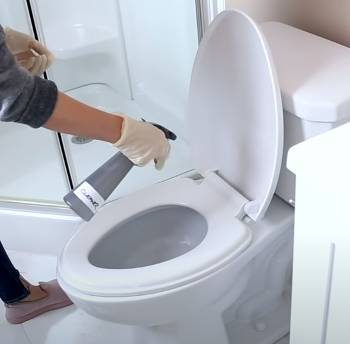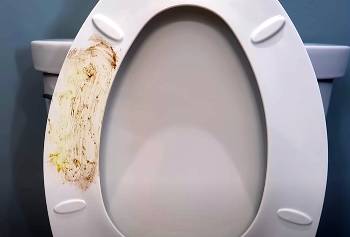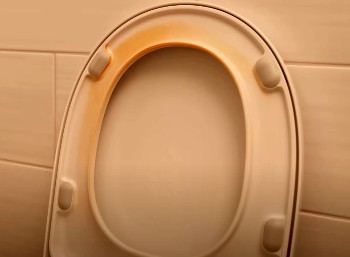Who doesn’t want a clean toilet to have the ultimate relaxing feeling after having a long hectic day or at the beginning of the day? I am pretty sure that you are no different.
But once in a while when you see that there is some sort of residue in the toilet, I am sure that disgusts you, and your mood remains off for a long time. Imagine, one fine day, you see legs leaving residue on the toilet seat in your bathroom.
How would you feel then?
And, how can you eliminate it and keep your toilet seat clean always? Well, after going through this article you will get some idea for sure.
Leaving Residue On The Toilet Seat

No matter how much you try you will find it impossible for some people to make the toilet usable for the next user after they use it.
They will always go out from the toilet leaving black residue on the toilet seat and the next person who would enter the toilet to use it will find it extremely unpleasant.
So, why do some people leave dirt on the toilet seat?
Well, there are so many reasons. The first reason is often people remain unaware of the fact and other users are too shy to speak about it.
But sometimes other than this reason there could be reasons related to health issues.
For instance, there might be different skin-related issues that are creating dirt or residue on the toilet seats by some users. In that case, at first, the person who is suffering from the disease needs to be aware and get treatment.
On the other hand, the toilet needs to be cleaned and disinfected once the residue and the dirt is being identified before anyone else uses it.
Reasons Behind The Legs Leaving Dirt/Residue On Toilet Seat
There could be so many reasons that can play a vital role in the legs leaving spots on the toilet seat. So, let’s find out all those reasons that might be causing these issues.
- Skin Disease Of The User Of The Toilet

Not all people have perfect skin due to various reasons people may suffer several skin diseases, especially in an area like the thighs which are more prone to having bacteria in it.
Some people may start using various commercial products or medicines with it.
While using the toilet that skin part gets in contact with the toilet seat, as a result of this the spot remains on the toilet seat.
So, if the user remains unaware the spots will be noticed by the next user of the toilet, and he will have a hard time while using it.
- Body Oils and Dead Skin Cells
Our bodies continuously produce oils and shed dead skin cells. When your bare legs come into contact with the toilet seat, oils and skin cells can rub onto the surface.
Over time, these can build up and leave stain-like residues. The oils can react with the porcelain or plastic seat material to create a grimy film.
- Hair Products
Hair care products like gels, mousse and sprays contain waxes, silicones and other ingredients that can transfer onto toilet seats.
Sitting with residue from these products on your legs can lead to marks and stains over time.
- Dyes and Inks
Dark colored clothing, especially jeans and leggings, may contain excess dyes or inks that rub off. The friction when your legs touch the toilet seat can transfer colorant and chemicals, reacting with the seat’s surface to leave stains.
- Mineral Deposits
Hard water contains mineral deposits like calcium and magnesium. As water evaporates from your wet legs or from cleaning the toilet, it can leave behind mineral residue.
This appears as whitish hard water stains on the seat.
- Bacteria and Mold
Moist, dirty toilet seats can allow mold, mildew and bacteria growth. This bio-gunk can spread onto your legs when sitting, and get deposited back on the seat surface as stains.
- Having Oily Thighs Or Dirt In The Thigh
Some people have naturally oily skin. It is a very common condition that can affect both men and women. And this condition influences different parts of the body like the thighs that get in contact with the toilet seat.
This particular condition is caused by the sebaceous glands that ultimately lead to sebum oil production. So, such a skin type attracts all the dirt and other contamination to the skin significantly.
And all this dirt gets to the toilet seat from the thigh of such user leaving the spot on it.
There are different factors that can cause oily skin like pregnancy, hormonal issues, hot weather, cosmetics, birth control pills, poor dietary habits, and so on.
- Skin Is Peeling Off
For different reasons, the human skin can start peeling off. And that can remain on the toilet seat after the use of the patient. Such issues can start from any part of your body.
In some conditions, this issue happens in the body, like disorders in the immune system, genetic disorders, allergic reactions, fungal infection, cancer, allergic reaction, and so on.
There might be some diseases as well to cause this problem like having extremely dry skin and some unusual diseases.
- Very Harsh Cleaning Product
We tend to use so many chemical products every day. Not all are very suitable for our skin for sure as the elements are not natural.
Moreover, so many cleaning products of the skin contain harmful chlorine bleach that can cause serious irritation on the skin, causing significant harm.
All these make the skin shed and leave the skin on the toilet seat.
- Wearing Tight Or Uncomfortable Clothes
Tight or uncomfortable clothing can also cause skin irritation and the skin may eventually be shed on the toilet.
How To Solve The Issue Of Legs Leaving Residue On The Toilet Seat?

Now that you know all the catalysts working behind the legs leaving residue on the toilet seat issue, then you must be wondering how can you solve this particular problem.
Any residue that is left in the bathroom can entirely ruin your bathroom experience.
That is why it is time to troubleshoot the issue of legs leaving dirt on the toilet seat without any further delay.
- Cleaning The Toilet Seat After Each Use
It is the duty of all individuals to leave the toilet seat clean after use. You can clean the toilet seat with a disinfectant.
After that, it would be better to clean the toilet seat with toilet tissue to keep it dry.
- Choosing To Use A Squatty Toilet Stool
It is the natural position that is recommended by most of the experts that can ensure that the users are not getting touched by the toilet seat.
Also, the position of the toilet is also pretty good for ensuring the healthy usage of the toilet.
- Using Toilet Seat Covers
You can stop the leg residue to remain on your toilet seat by using a toilet cover. These are available in almost every retail store, and they can be used in toilets of every place like offices, schools and even at home.
- Maintaining Personal Hygiene For All The Individual
All individual needs to be aware of the maintenance of personal hygiene. If you are having a difficult time on your skin, then get it treated without any delay.
And awareness regarding the usage of the toilet is very crucial for people suffering from skin issues.
So, by doing all these you can make sure there is no residue left on your toilet seat from the legs of the user.
Tips for Removing Existing Toilet Seat Residue
If your toilet seat already has built-up residue, here are some tips for tackling the grime:
Make a DIY Cleaning Solution
For light stains, mix:
- 1 part vinegar
- 1 part water
- Few drops dish soap
For tougher stains, try:
- 1 part bleach
- 3 parts water
Apply the solution and let sit 5-10 minutes before scrubbing and rinsing. Always spot test first.
Baking Soda and Vinegar
Make a paste with baking soda and vinegar. Apply to stained areas, let sit 20 minutes, then scrub and rinse. The chemical reaction can help dissolve grime.
Magic Eraser
Dampen a melamine foam magic eraser sponge and gently rub stained areas. Rinse thoroughly after.
Toilet Brush Scrubbing
Use a stiff toilet brush with your cleaning solution to help manually scrub off stain buildup.
Remove Toilet Seat
For thorough cleaning, unscrew and remove the toilet seat. Take it outside or to the tub and use a scrub brush and cleaning solution. Letting it soak 10-20 minutes can loosen stubborn grime.
Frequently Asked Questions (FAQs)
When you see some black stuff on the toilet seat of your then be assured that there is the presence of molds, mildew, bacteria, and minerals in your toilet. Only cleaning the toilet regularly can save you from those.
When there is stagnant water in your toilet it can work as a catalyst of getting mold on it quickly.
There are a few foods in our diet that has the possibility of triggering dermatitis. Those foods are milk, soy, wheat, fish, eggs, and peanuts.
It doesn’t happen often. But the urine of the pets can eventually deteriorate and can trigger mold growth.
Blackish toilet seat residue is typically caused by:
1. Accumulated body oils and dead skin cells – These contain melanin that causes a darkening effect over time.
2. Dyes transferring from dark clothing rubbing onto the seat surface.
3. Mold or mildew growth on a moist toilet seat.
4. Chemical reactions with seat materials like porcelain or plastic.
Common toilet seat residues consist of:
1. Body oils and dead skin cells – This rubs off bare skin onto the seat.
2. Hair product waxes and silicones – These transfer from legs and buttocks.
3. Dyes from colored clothing – Mainly dark dyes from jeans and leggings.
4. Hard water mineral deposits – Calcium and magnesium salts.
5. Mold and bacteria growth – Can create dark stains.
Wrapping Things Up
It is really a nightmare for all of us to have legs leaving residue on the toilet seat when we enter into a toilet to get the long-awaited relief.
There are different causes behind this problem as you can see and just taking some precautions and the awareness of the users can mitigate this problem tremendously. So, the next time you encounter this problem, you will know what to do about it.
